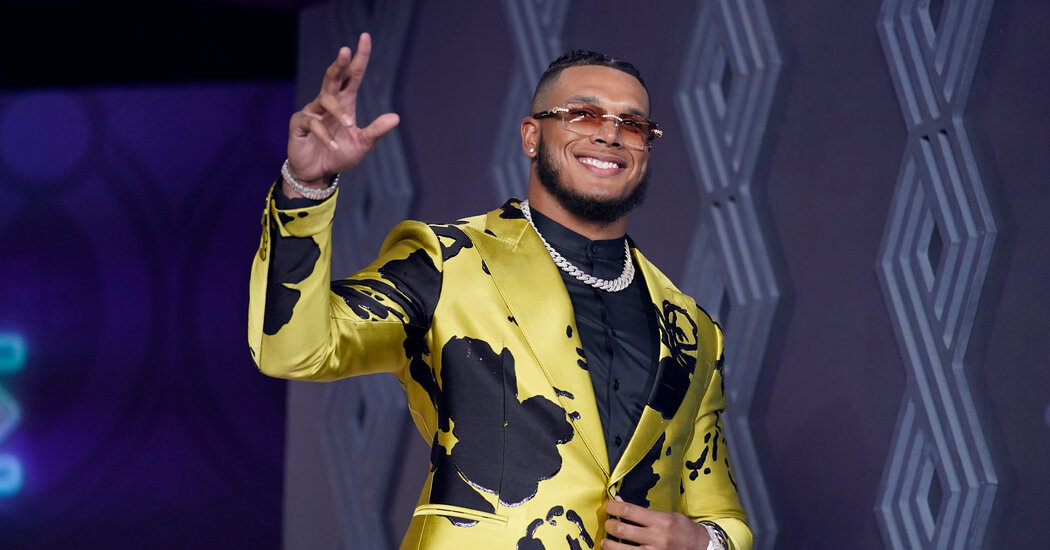
Is it possible the last red carpet that is genuinely a place of self-expression rather than big brand fashion marketing belongs to the N.F.L. draft?
So it seemed, judging from the athletes’ entrances on Day 1 of the draft in Las Vegas. It was like a wake-up call: Remember when? Remember when celebrities dressed themselves, for themselves? Remember when they took risks and showed their personalities through their clothes? Remember when you never quite knew what you were going to get because it hadn’t all been preordained via contract months before?
Sure, there were some glossy, global names represented on the step and repeat by the Bellagio fountains — the kind of names that dominate shopping streets and award shows everywhere. But they faded into the background against the statement storytelling going on in the draft class outfits: the bright, Easter egg colors; the details; the giant chunks of bling.
As athletes increasingly dip into the world of personal branding for their post-sports or parallel-sports careers (hello, Tom Brady), self styling from head to foot has become practically an art form unto itself. And it starts at the draft.
That’s why, alongside the actual ranking of first picks, a shadow fashion ranking has increasingly developed; see assorted N.F.L. draft fashion brackets. It’s not just about attention on the night. It’s about setting a tone and laying the groundwork for the future.
(Also, perhaps, ensuring an alternative future, if things don’t quite work out on the field.)
So there was Jermaine Johnson II, picked 26th, in a gold jacket splashed with squiggles of black flowers like a giant gilded lily-with-Rorschach-blots, lined with the logos of the teams — from high school through junior college and college — that had helped get him to Vegas.
Ikem Ekwonu, picked sixth, in a white suit with green and white stripes on one lapel and at the cuffs, reflecting his family’s Nigerian roots.
And Ahmad “Sauce” Gardner, picked fourth, in light blue with two enormous necklaces clanging around his neck, one dangling what looked a lot like a sparkly Tabasco sauce bottle, the other spelling out “Sauce.” Just in case anyone didn’t know who they were looking at.
Aside from Kayvon Thibodeaux in a black Dolce & Gabbana tuxedo trimmed in ruby crystals and complete with bow tie, and Matt Corral in royal blue Brioni, the brand-name-dropping was limited to the bottom — i.e. the shoes — which was probably a coincidence, but also seemed pretty apropos, given ranking was the theme of the night.
Note, for example, Mr. Gardner’s spiked Christian Louboutin sneakers; Garrett Wilson’s giant lug-soled Prada boots, which he paired with a two-tone gray and white suit and multiple pearl necklaces, like the Harry Styles of football; Jameson Williams’s bright red and white Vuitton kicks, chosen to match his bright red suit, white shirt and Olympic-medal-size medallion; and Nakobe Dean’s white McQueens, which he wore with a pale pink suit, a white leather shoulder harness and a broad-brimmed brown fedora, tilted just so, with a matching blush pink ribbon.
A look that ensured, even though his name wasn’t called in the first round, he was pretty much unforgettable.
It makes sense.
After all, if the goal is, at some point after making a lot of other goals, to leverage your achievements and name recognition to edge into the lifestyle arena, establishing an individual, identifiable look is key. That’s not about snagging an ambassadorship for an established fashion brand (though fashion may yet attempt to seduce football, as it has basketball and soccer, in a more encompassing way); it’s about establishing your own brand. And that means you don’t want to let another designer define you. You want to define yourself.
Which in turn means the draft is not just the moment when a new class of potential professional sports stars emerges; it is the moment that their branding begins.